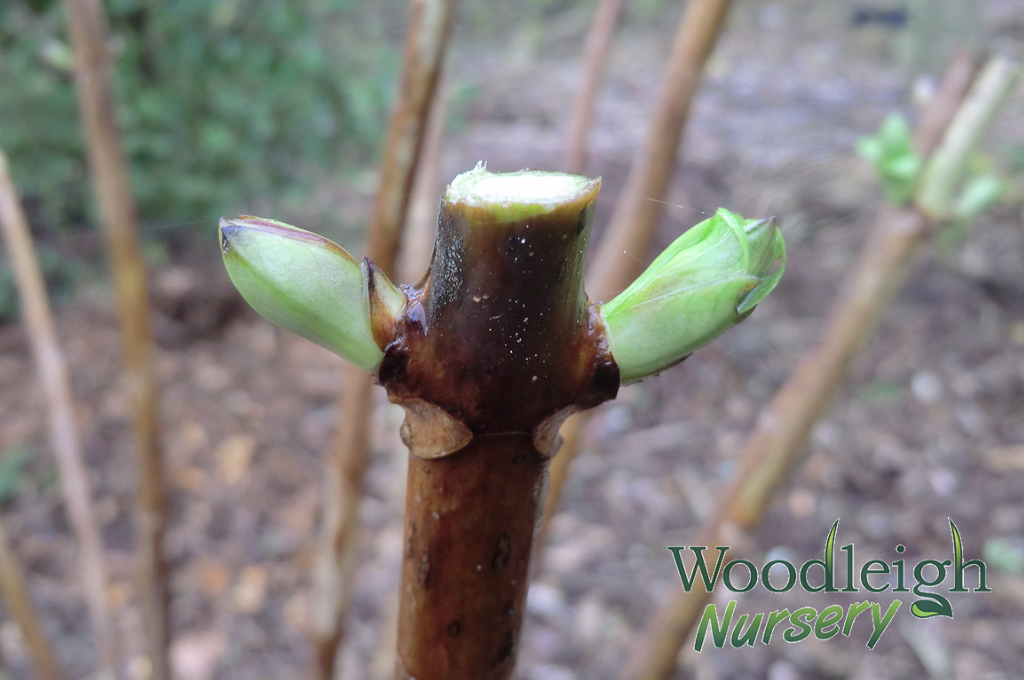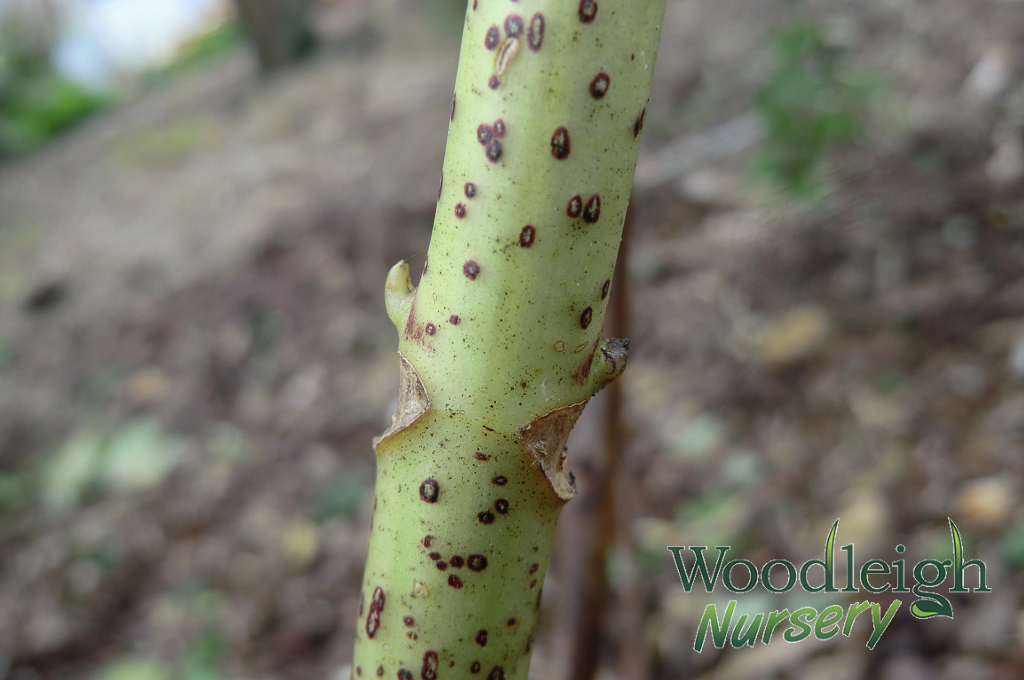Cultivation notes
The online version of our catalogue is here. Alternatively, you can download and print our catalogue:
October 2023 Woodleigh Nursery Catalogue [PDF].
Updated 12 October 2023
Where can I find sales & dispatch information? Please go to our How to Order page.
Cultivation Notes
Hydrangea species, cultivars and hybrids
Woodleigh nursery propagates what we believe to be New Zealand’s largest range of Hydrangea species, cultivars and hybrids. Many people are familiar with the macrophylla types, however from our collection we have made available a choice range of plants to suit varying sites, colour preferences, and flower/foliage forms. To help in your review and selection of the types available we have prepared a useful comparison table here: Woodleigh Nursery Cultivar Table [PDF]
Colours
The macrophylla or large leaf Hydrangeas are fabulous shrubs for providing colour all summer and into autumn. Many have heads which change colour in the autumn, we call this ‘antiquing’. Many are ideal cut flowers.
Hydrangea colours are nearly all changeable depending on your soil. Alkaline or limey soils give pinks and reds while acid soils make for good blues.
I recall my grandmother talking about putting rusty nails beneath some of her hydrangeas to make them blue and egg shells around others to make them pink. In reality it is more difficult than this to change the colour of your hydrangeas.
Blue Hydrangeas
It is the presence of available aluminium in the soil that makes hydrangea flowers blue.
Most acidic soils (pH 5.2 – 5.5) in New Zealand have freely available aluminium. In soils with a higher pH (lime or alkaline soils) the aluminium is locked up and is less available to plants.
There are a couple of things you can do to amend the soil to achieve blue flowers if you do have alkaline soils:
- Adding aluminium sulphate will lower the pH and add aluminium to the soil. Apply little and often to avoid burning the roots of plants; 2 – 3 times through the growing season is recommended. Ensure plants are well watered prior to applying. Apply at a rate of 30g (2 Tablespoons) per square meter, and water it in. It may take a few years for the plants to accumulate enough aluminium to achieve full blue colour.
- Adding organic material will also help to acidify the soil (lower the pH) thereby increasing the availability of aluminium – grass clippings, leaves, fruit and vegetable peels, animal manures. This may be a slower and less reliable method than that set out above.
Areas of New Zealand blessed with volcanic soils have allophanic soils (allumino-silicate clays) and typically present beautiful blue hydrangeas.
Note – if you want a blue hydrangea select a good blue variety such as Adria, Blue Meisse, Gentian, Renate Steiniger or Vibraye; rather than attempt to turn a pink variety blue. While some varieties will produce either a good blue or a good pink this is not always the case.
When you purchase your blue hydrangea it will often be pink / purple for the first year or two as they will have been grown in potting mix which typically does not have aluminium in it. This may also happen if you shift your plant as roots will be cut interrupting the supply of aluminium to the plant.
Pink Hydrangeas
Let’s uncover the mystery of pink and red hydrangeas.
Pink and red flowers are produced when there is no aluminium in the soil. This can be achieved in a number of ways:
- Lime or alkaline soils (pH of 6.5 or above) – these are great for growing beautiful pink and red hydrangeas as there is no available aluminium. In these soils certain plant nutrients are locked up and are unavailable to plants. Aluminium is one such nutrient.
- Applying lime – if you have acid soils (with a pH of below 6) one option is to add a couple of dressings of lime (spring and summer) each year to increase the pH. Care needs to be taken though to avoid other acid-loving plants such as rhododendrons. Note – over application of lime can cause chlorosis or leaf-yellowing.
- Phosphate fertiliser – is another option for acid soils. Application of a fertiliser with an NPK ratio of 10-30-10 should be sufficient to change the flower colour. Phosphate also locks up aluminium making it unavailable to plants.
- Coastal sandy soils – the aluminium is readily leached out of sandy soils.
- Pots and tubs – potting mix generally does not contain aluminium. Check fertiliser to ensure it does not contain aluminium.
- Planting near a spring or running water – the aluminium will be washed away or leached out of the soil.
- Planting near concrete – the cement in concrete contains lime which leaches into the soil raising the pH and locking up aluminium.
Some areas of New Zealand have naturally alkaline (limey) soils such as the peat soils around Cambridge, parts of Te Kuiti and Palmerston North and typically grow brilliant reds and pink without effort.
Note – if you want a pink hydrangea select a good pink variety such as Alpenglow, Bloody Marvellous or Colonel Durham; rather than attempt to turn a blue variety pink. While some varieties will produce either a good blue or a good pink this is not always the case. Some varieties such as Paris, and Mrs Kumiko try very hard to stay red / pink in acid soil.
Grandma’s Hydrangeas
We have a range of charming old Grandma Hydrangeas. Grandma Hydrangeas are a series of forgotten varieties that were nearly lost to cultivation. Most of these have disappeared in Europe; and in NZ haven’t been available for decades. We are indebted to the late Os Blumhardt for keeping these plants when everyone else had forgotten them. The varieties with an ** are ones from Grandma’s day.
Cultivation in a nutshell
Hydrangeas like plenty of moisture and most will perform well in sun or shade. A mulch of bark or wood-chip will retain soil moisture and improve their health.
You will be able to select hydrangeas to suit your conditions, whether it be moderate frost, sunny dell or moderate coastal exposure.
The smaller growing varieties make excellent tub and patio plants. You may have more influence on colour display when cultivating tub grown plants.
If you know of a friend who might like a catalogue, please feel free to spread the word about Hydrangeas and provide our contact details!
Hydrangea Pruning
Yes, it is that time of year again, the time for winter pruning; a job that both Quin and I really enjoy. In our earlier life when we had an Arboricultural (Tree Surgery) business. We covered the full range of pruning from large trees, shrubs, to fruit trees, roses and even hydrangeas (those were the jobs I loved).
The winter here has been very mild, confusing for many of our plants. Recently though, we have had a few really good frosts, followed by gorgeous sunny days. It has been a good winter chill to kill some of those bugs, and hopefully delay the spring growth. I just want to get out into the garden to start the winter pruning and renovation – remove some of those unwanted plants to make room for new plantings.
We are sometimes asked ‘Why do we prune?’ & ‘Do we have to prune?’
There are 3 reasons that we like to prune plants:
- To remove dead and diseased wood.
- To improve or maintain the shape of a plant
- To increase flowering and fruiting – when pruning hydrangeas, we aim to reduce the number of individual flower heads, enabling the plant to produce larger, better-quality flowers.
No, it is not essential that you prune your hydrangeas each year. The new growth will emerge and eventually smother the old flowers. The bush will be covered in many small flowers.
Late July is a good time to prune your hydrangeas; though if you are in an area that receives late spring frosts you may like to wait a few more weeks.
Winter pruning of Hydrangea macrophylla and Hydrangea serrata types:
- Remove all dead, damaged or diseased material
- Remove thin, spindly, crossing or crowding stems
- Reduce the height of the remaining strong stems, keeping 1 – 2 pairs of fat flower buds.




The flower buds are usually in pairs near the top of the stem and vary in size with different varieties. The leaf (growth) buds are below these and are smaller in size.
The Hydrangea paniculata types like to be treated differently.
These do need to be pruned each winter and pruned quite hard to ensure that the plant puts out strong stems that can carry the heavy flower heads.
For the first 3 years after planting prune to create a strong framework of 3 or 4 strong stems in a vase shape. In subsequent winters remove all growths back to the base shape leaving 2 or 3 buds at the base of each stem.
Janica and Quin Amoore Woodleigh Nursery 300 Mountain Road RD 3 New Plymouth 4373
tel +64 21 072 7394 (phone or text) | email janica@woodleigh.co.nz
